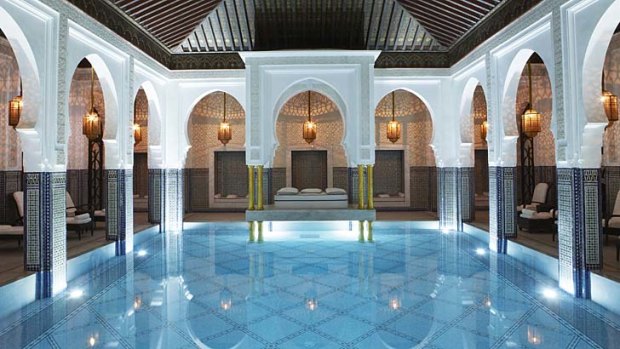
Marrakesh magic... laps at La Mamounia.
From glittering oases to elite riads, Marrakesh has an impressive array of new boltholes, writes Lydia Bell.
Coils of tangerine bougainvillea, fat palms throwing shade on emerald lawns, the scent of orange blossom and jasmine. I'm standing in 50,000 square metres of Balinese-inspired gardens in North Africa, surrounded by waterfalls, ponds and a vast swath of decorative pool in what is in essence a desert. Another day, another mind-blowing Marrakesh hotel opening.
This time it's Palais Namaskar in the Palmeraie, the parched, palm-studded expanse populated by millionaires, which extends south of the city's medina and is home to a growing number of walled oases. It is just half an hour's drive from the madness of the souks but closer to a wild Atlas hinterland. Palais Namaskar is a sleek, contemporary retreat with top-notch Francophile cuisine from a former Plaza Athenee chef and a wildly glamorous, princessy Ila spa, whose rhassoul-clay masseurs include a kung fu Olympian and where blow dries and make-up jobs post-massage come as standard. It is part of the Oetker Collection, which includes the French Riviera's classiest grande dame, the Hotel du Cap, and guests can be whisked by Falcon 900 LX jet between Oetker sister properties.
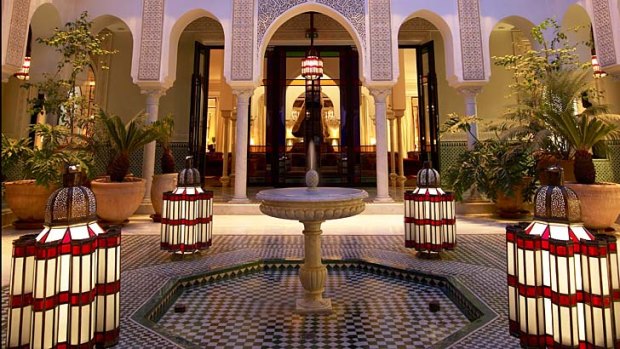
Dusk at La Mamounia.
Namaskar isn't the only opening in the Palmeraie this season. There's also Le Selman, designed by Jacques Garcia, the interiors guru du jour who also oversaw the new Pearl in Marrakesh and the high-profile refurbishment of the iconic La Mamounia. A red-brick interior conceals Le Selman's 56 rooms and suites and five riads with an orientalist-luxe style: black-stained plasterwork, fine carpets, Versailles-inspired chairs. A coterie of thoroughbred horses is available to ride in the desert and an Espace Vitalite Henri Chenot spa provides pampering and pummelling.
The luxury marques are congregating in the Palmeraie, too. The Taj group is reconfiguring the shell of an abandoned Mandarin Oriental project that was used in the filming of Sex and the City 2 and the hotel is due to open next year. W and Rocco Forte have also brokered headline deals.
Money might have been no object in these openings but these aren't folly projects - every hotelier wants a crack at this city. A direct flight from London and European capitals, Marrakesh's compelling mix of medina and souk, mountain and desert is catnip for Europeans seeking a short, sharp blast of the exotic: less than two hours after leaving home they can be staring a devilish snake charmer, monkey wrangler or henna tattooist in the eye, inhaling the aroma of orange skin and barbecue smoke and bargaining hotly over babouche slippers and inlaid boxes. This is a city of exciting contrasts, where Italian photographers and French models dwell among Berbers whose hooded garb inspired George Lucas's Jedis in Star Wars.
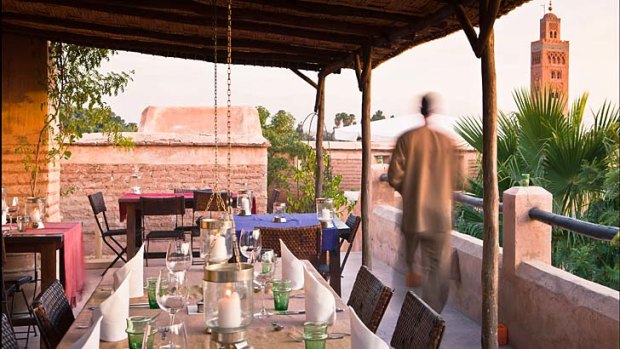
The view from Riad El Fenn.
Holidaying Gulf Arabs also pour into the kingdom in droves, so vast quantities of Emirati investment capital have followed.
With perhaps half the riads of Marrakesh's medina owned by (mainly European) foreigners and for sale on the open market, and with most of the top-end hotel chains present - or planning a presence - the decision about where to stay can be quite confusing, for the sheer quantity of hotels and rentals is disproportionate to the desert city's modest size.
Until recently, travellers made the choice between a riad in the medina - sleek retreats that belie the chaos of life outside their fortress-like doors - or the plush hotels set on landscaped properties in the Palmeraie. Many savvy travellers chose not to stay in the new town (that is, beyond the medina walls) because hotels there have tended to be blandly modern, lacking the artisanship and ingenuity that are the hallmarks of fine Moroccan hotels. But now the new-town neighbourhoods of Hivernage and the Route d'Amizmiz are coming up trumps, a nouveau-Marrakesh focal point for European-style restaurants and cafes. Ultra-modern new hotels in these districts have raised the bar: Sirayane Boutique Hotel & Spa, a modern kasbah with top-end restaurant and spa, opened recently, after last year's opening of Four Seasons.
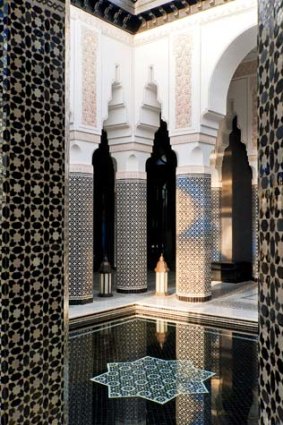
A tiled courtyard at Le Selman.
Set to open soon in Hivernage are The Great Getaway, comprising lodges and tents in a poolside palm grove, the 72-suite Pearl, styled by Jacques Garcia, and a Marrakesh outpost of London's Baglioni, the interiors project of Jade Jagger. Francophile cafes are popping up apace, such as Brasserie de Flore, an early 20th-century-style French brasserie decorated with crystal chandeliers and fans, plus interiors and clothing shops selling not-too-folkloric pieces, such as Akbar Delights' new sister store, in Gueliz, which melds traditional Moroccan embroidery and couture techniques to create exquisite tunics, cushions and other objets.
Fashion editors download their tips from the website of personal shopper Laetitia Trouillet (lalla.fr), who has her own boutique in Gueliz and hand-held Sarah Jessica Parker when she was in town. Meanwhile, within the old city walls, more palaces and riads are re-imagined every season.
For the time being, nothing can match Riad El Fenn and Riad Farnatchi. Host of this year's Marrakesh Biennale, Riad El Fenn is owned by Richard Branson's sister, Vanessa, and is where guests rub shoulders with photographers, writers and artists. The work of top British artists lines the walls of the riad's 21 rooms and suites and there's a hammam, marble pool, mini cinema and panoramic roof terrace.
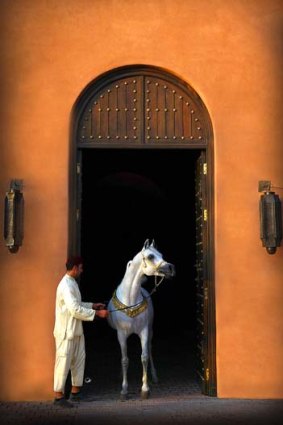
Saddled at Le Selman.
Hidden in the medina, the five-suite Riad Farnatchi is the sine qua non of modern riad glamour, melding tradition and 21st-century chic. Djellabas - Arabic robes - are provided so you can wander around dressed like a Berber - no one will bat an eyelid.
Inside the medina, it is worth looking at the three-storey Maison de la Photographie, which opened a few years ago in a building centred on a columned "foundouk" courtyard, topped by a terrace cafe. French art and cultural expert Patrick Manac'h and his business partner, Hamid Mergani, acquired 5000 photos and 2000 glass plates from the archives of the French protectorate, covering the period 1862-1950 and offering a rare glimpse of Moroccan life in the late 19th and early 20th centuries.
New this year, Salama is a restaurant just 10 metres from the Grand Cafe de France on famous Jemaa El Fna Square. It has generous servings of modern Moroccan cuisine, a great view of the medina from the terrace and an exuberant orientalist ambience, with febrile belly dancers twirling around with plates of lit candles on their heads.
Even if you're not staying at the famously refurbished La Mamounia, do settle for afternoon tea in the original Moorish-chic establishment , or eat in one of its four restaurants, which have two Michelin stars between them.
Exuding old-school glamour, La Mamounia is set in royal gardens and was beloved of Winston Churchill and his buddy Franklin D. Roosevelt. This is where Cecil Beaton photographed the Rolling Stones and where the great and the good stayed in the time of Hideous Kinky, before the advent of cheap budget flights and mass tourism, when Marrakesh was still evolving from a provincial desert trading post.
In recent years a Jacques Garcia refurb of its 209 rooms and suites has put the spring back in its step and restored its original One Thousand and One Nights concept (to the chagrin of some returning clientele).
But to shoot right to the top of the hotel tree, book into Royal Mansour, unveiled by King Mohammed VI two years ago.
This collection of 53 private riads with their own butlers is the stupendously impressive work of the king's own craftsmen and is allowed to call itself "the embodiment of Moroccan living as an art form".
If you tire of heady orientalism, you might look to the mountains that ring this city and wonder what lies beyond. Call Maurice, of Ciel d'Afrique, who will whisk you high in his magical balloon so you can watch dawn break over the Djebilet Hills.
FAST FACTS
Getting there
Swiss Airlines has a fare to Marrakesh from Sydney and Melbourne for about $2480 low-season return, including tax. Fly with a partner airline to Hong Kong (about 9hr), then to Zurich (13hr 11min) and to Marrakesh (3hr 30min with a partner airline); see swiss.com. This fare allows you to fly via other Asian cities and back from another Moroccan or European city.
Staying there
- Palais Namaskar has doubles from €390 ($468); palaisnamaskar.com.
- Le Selman has doubles from €359; www.selman-marrakech.com.
- The Great Getaway has doubles from €150; the-great-getaway.com.
- Pearl has doubles from €400; hivernage-collection.com/en/pearl.htm.
- La Mamounia has doubles from 6000 dirham ($655); mamounia.com.
- Riad El Fenn (pictured right) has doubles from 2900 dirham; riadelfenn.com.
- Riad Farnatchi has doubles from 3100 dirham; www.riadfarnatchi.com.
- Royal Mansour has doubles from €550; royalmansour.com.
- Sirayane Boutique Hotel & Spa has doubles from €139; uk.sirayane.com.
Eating, touring there
- Brasserie de Flore is in Marrakesh Plaza, Place du 16 Novembre, Gueliz; brasseriedeflore@yahoo.fr
- Salama Marrakesh is at 40 rue des Banques, Kennaria, Jemaa El Fna; +212 524 391 300.
- Maison de la Photographie is at 46 Rue Ahel Fes, Marrakesh medina; maisondelaphotographie.ma.
- Ciel d'Afrique runs balloon toursfrom Marrakesh; www.cieldafrique.info.
Sign up for the Traveller Deals newsletter
Get exclusive travel deals delivered straight to your inbox. Sign up now.